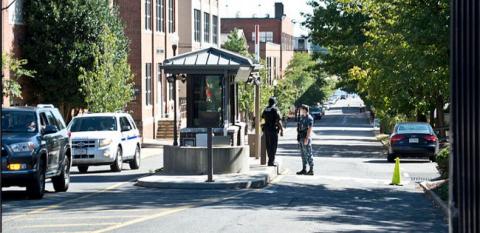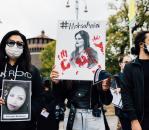Aaron Alexis’ Military Service Is the Clue to Navy Yard Shootings

From our content partner, New America Media:
BANGKOK, Thailand – As media pundits scrounge through Aaron Alexis’s background for clues to the uncontrolled fit of rage that led him to gun down 12 civilians at the Washington Navy Yard, a most egregious accusation has been raised against his devotion to “the dark side of meditation.” Critics have charged that Thai Buddhist meditation classes promoted his psychological detachment from reality, implying such practices amplified the voices in his head and thus impelled him to mass murder.
In a further attempt to shift the blame onto the tiny Thai community in America, the New York Post in tabloid-style claims that his break-up with a Thai girlfriend and a frustrating trip to Bangkok to find another soulmate led to the pent-up rage that was later unleashed in gunfire. This sort of speculation is demeaning and completely irrelevant, since couples break up every day of the year without venting their grief in a suicidal shooting spree. His target was not his ex-girlfriend and her circle of friends in either Texas or Thailand, but unrelated victims at his workplace in Washington, D.C.
These sorts of conclusions put the cart before the horse. From medical records and accounts of his acquaintances, Alexis was well aware of his emotional difficulties and had sought help from his VA hospital and wherever he could find it, and one source of comfort was the Wat Busayadhammavanara temple on the outskirts of Fort Worth, Texas.
For a brief period in the suburb of White Settlement, Alexis was employed as a waiter at a Thai restaurant owned by a couple who encouraged his meditation lessons as a path toward resolving his anger issues. Apparently in Vipassana meditation, he found some relief and peace of mind from the constant anxiety that caused him to carry a .45 caliber handgun in fear for his life. Whatever prompted his feelings of insecurity and terror arose from a source unrelated to that temple and the Thai community.
His defensive reactions, which led to two earlier incidents of non-injurious gun violence, were likelier linked to traumatic experiences during his military service as a full-time Navy reservist with a secret-level security clearance. The nature of his missions remains undisclosed by the Pentagon and probably never will be revealed in accurate detail.
A Troubled Generation
Alexis attributed his mental-health issues to his assignment in cleaning up contaminated debris at the 9-11 Ground Zero site, but the Navy claims no such record of this work. A report in British paper Daily Mail notes Alexis was seen exiting a subway near the World Trade Center just as the twin towers were collapsing. The sight, it says, quoting Alexis' father-in-law, left him "traumatized."
Indeed, the career of Alexis runs parallel to the 9-11 era, when thousands of servicemen were assigned to secret combat missions that do not appear on their military records.
Another troubled Navy reservist, Christopher Dorner, was trained as a sniper at Fallon air station, Nevada, and with an elite commando unit that required every member to swim with full combat gear from Camp Pendleton on the California coast to military-controlled San Clemente island – a nearly superhuman feat. As a sniper, he was sent on secret missions into Iraq, the nature of which the Pentagon has never disclosed. Those blank pages in his record undoubtedly are key to understanding his personal rebellion against the government that he had served, and are key to unraveling the alleged double homicide and other fatal shootings Dorner is accused of perpetrating in the Los Angeles area.
The Washington Navy Yard incident is rife with many other inconsistencies. Alexis owned an AR-15 rifle but his blue-clad body was found only with a shotgun and two pistols, while military veterans at the shooting site heard the distinct sound of gunfire from an AR-15 and saw a second shooter dressed in green holding this very same model of automatic weapon.
If any of the above factors haunted his military career, then Alexis had good reason to seek out Vipassana meditation, which was developed by Sinhalese Buddhists in ancient Sri Lanka and then transmitted to Thailand.

Diversion Tactics
To blame meditation by Thai Buddhist practitioners is a cheap trick aimed at diverting public attention from the home-grown causes of gun violence. Buddhism, especially of the Theravada school practiced in Thailand, stands firmly opposed to these sorts of overbearing societal pressures and, to the contrary, tries to help individuals rediscover their genuine mental grounding, which in Judeo-Christian terms could be called moral conscience. When Alexis turned to Vipassana meditation, it was to free himself from the shackles that imprisoned his mind.
This is not to say that Buddhism is entirely peaceful as is commonly assumed. There are political factions in Buddhist societies that, for reasons of material interest, advocate violence. This is obviously the case in places like Sri Lanka, Myanmar and Japan in the wartime period, where fanatic monks or priests have urged brutal attacks against minority religious groups and foreigners. These gross violations of the Buddhist doctrine of non-violence are based on secular power struggles that exploit religious differences. Some of these same problems apply to Tibetan Tantric Buddhism in the politically complex struggles inside and outside its homeland.
The Southeast Asian temples in the United States are not associated with any of these deviant teachings but remain true to the original calling of helping people resolve their personal troubles and live together in harmony. Most of these religious communities – Vietnamese, Cambodia and Laotian – arrived as refugees, while Thais came as students or economic migrants. These subgroups are by no means free of violent crime against each other or against other Americans, as has been shown in several shooting incidents in Minnesota and on the West Coast. If anything, these communities have been occasional victims of discrimination and violence, as in the case of the murderous attack on schoolchildren in Stockton, Calif., in the late 1980s. In none of these past cases of violence has Buddhism or meditation ever been suspected as the cause of crime.
To borrow a phrase from Jesus of Nazareth, the wider solution to the Aaron Alexis mystery is: Physician, heal yourself. The root problem resides in the violence of American political power, not in the nonviolence of Buddhism.
Author Bio:
Yoichi Shimatsu, a Hong Kong-based science writer, is former editor of the Japan Times Weekly in Tokyo and associate editor of Pacific News Service, the predecessor of New America Media.
Photos: Tim Evanson (Flickr); New America Media.































































































































































































































































































































